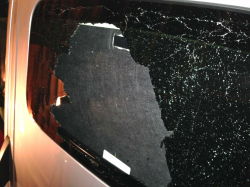— A Ford sunroof class action lawsuit has been dismissed after the judge ruled the plaintiff couldn't show that Ford panoramic sunroofs are defective or shatter on a regular basis.
The class action lawsuit says plaintiff Jessica Beaty purchased a 2013 Ford Escape with a panoramic sunroof in September 2012, but she says her sunroof spontaneously shattered while she was driving on the freeway in February 2017.
The plaintiff claims the panoramic sunroof tempered glass is too thin to cover the large area needed for the roof and they shatter due to manufacturing defects in Escapes and these Ford models.
- 2007-present Ford Edge
- 2009-present Ford Focus
- 2010-present Ford Fusion
- 2011-present Ford Explorer
- 2009-present Ford Flex
- 2011-present Ford F-150
- 2009-2014 Ford Mustang
- 2008-present Ford Escape
- 2014-present Ford Transit Connect
- 2013-present Ford C-Max
- 2007-present Lincoln MKX
- 2009-2015 Lincoln MKS
- 2013-present Lincoln MKZ
- 2010-present Lincoln MKT
- 2010-2011 Mercury Milan
- 2010-2011 Mercury Montego
Ford didn't cover the replacement under warranty, so she went to an auto glass business and paid a $500 insurance deductible to replace the glass. She also says she lost more than $100 to pay for a rental car for the time it took to replace the sunroof.
Earlier the judge dismissed express and implied warranty claims but said the plaintiff could amend those claims, which she chose not to do.
Ford told the judge there is no defect with the panoramic sunroofs because the glass breaks in the exact way federal law mandates the glass to break, specifically into small round pieces.
Ford also references the rate its sunroofs shatter, estimated at 0.05%, a failure rate of less than 1% which is not material as a matter of law. According to the automaker, one sunroof out of every 2,000 vehicles is a rate equal or lower to shattered sunroofs in vehicles from other manufacturers.
The automaker also argues it couldn't have known about alleged sunroof defects because the 2013 Ford Escape was the first model year to include a panoramic sunroof. Ford says the plaintiff bought hers at the very beginning of production, meaning Ford could not have “known,” much less concealed, the alleged defect.
The plaintiff argues Ford has a duty to disclose “any systemic failure of a specific automotive part of which it was aware and concealed from the public.”
But the judge had serious issues with the plaintiff's claim that Ford was deceptive by not informing potential customers about parts of a vehicle that could have problems or may one day fail, including the sunroof.
The judge let the plaintiff know her argument wasn't logical.
"It defies common sense to claim that a manufacturer must disclose every single failure of any component or part to every potential purchaser, even if the failure is minor and not dangerous, or even if it has only happened a handful of times." - Judge Ronald B. Leighton
As for the warranty, Ford responded by pointing out the warranty had already expired on the vehicle when the plaintiff complained about the sunroof. In addition, the warranty clearly says, "glass may chip, scratch, crack or break, and that any such damage is not covered by the warranty."
The plaintiff argues exploding glass shouldn't be excluded by the warranty terms, but the judge agreed with Ford by saying sunroof glass is tempered and supposed to shatter when it breaks. So the glass isn't defective when it does exactly what it is supposed to do if it breaks.
Ford further showed data that indicated no serious injuries or crashes have occurred because of shattered sunroofs.
Ford emphasizes the National Highway Traffic Safety Administration (NHTSA) has never requested a recall of the sunroofs and documents filed with the government show vehicles from other automakers have higher rates of shattered sunroofs.
The judge also agreed with Ford concerning the plaintiff's claim that hundreds of sunroof complaints have been filed, but that doesn't change the fact that about one in every 2,000 Ford sunroofs break, a rate too low to consider the problem a material defect.
The judge also found the plaintiff's own expert claimed a Ford sunroof replacement rate of only 0.41%, a low rate that also includes incidents other than shattering, such as leaking or sticking sunroofs.
"A truly dangerous failure (like an exploding gas tank) is material even if it is rare, and in a different case a duty to disclose a material defect may arise even if the defect occurs only infrequently. But viewed in the NHTSA’s 'severity, frequency and consequences' context, the actual failure rates, and the evidence in the record, the Court cannot conclude that the defect at issue here was material, if it was a defect at all." - Judge Leighton
By finding entirely in favor of Ford, the judge ruled the plaintiff cannot support her fraudulent concealment claims against Ford as a matter of law and cannot show that Ford knew of and failed to disclose a material defect. Additionally, she can't "establish that any such failure caused her benefit-of-the-bargain damage."
The Ford sunroof lawsuit was filed in the U.S. District Court for the Western District of Washington - Beaty et. al., v. Ford Motor Company.
The plaintiff is represented by Terrell Marshall Law Group, Simmons Hanly Conroy LLC, and Greg Coleman Law PC.
CarComplaints.com has complaints about the vehicles named in the sunroof class action lawsuit.

